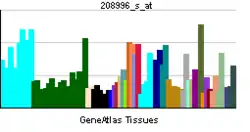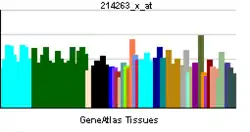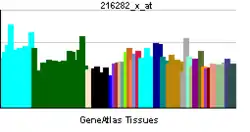POLR2C
Субъединица RPB3 ДНК-управляемой РНК-полимеразы II — фермент, кодируемый у человека геном POLR2C .[1]
Функция
Этот ген кодирует третью по величине субъединицу РНК-полимеразы II, полимеразы, ответственной за синтез мессенджера РНК у эукариот. Продукт этого гена содержит богатую цистеином область и существует в виде гетеродимера с другой полимеразной субъединицей, POLR2J. Эти две субъединицы образуют основной блок полимеразы. Псевдоген был идентифицирован на хромосоме 21.[2]
Взаимодействия
POLR2C, как было выявлено, взаимодействуют с:
Примечания
- Acker J., Mattei M.G., Wintzerith M., Roeckel N., Depetris D., Vigneron M., Kedinger C. Chromosomal localization of human RNA polymerase II subunit genes (англ.) // Genomics : journal. — Academic Press, 1994. — August (vol. 20, no. 3). — P. 496—499. — doi:10.1006/geno.1994.1208. — PMID 8034326.
- Entrez Gene: POLR2C polymerase (RNA) II (DNA directed) polypeptide C, 33kDa.
- De Angelis R., Iezzi S., Bruno T., Corbi N., Di Padova M., Floridi A., Fanciulli M., Passananti C. Functional interaction of the subunit 3 of RNA polymerase II (RPB3) with transcription factor-4 (ATF4) (англ.) // FEBS Lett. : journal. — 2003. — July (vol. 547, no. 1—3). — P. 15—9. — doi:10.1016/s0014-5793(03)00659-8. — PMID 12860379.
- Corbi N., Bruno T., De Angelis R., Di Padova M., Libri V., Di Certo M.G., Spinardi L., Floridi A., Fanciulli M., Passananti C. RNA polymerase II subunit 3 is retained in the cytoplasm by its interaction with HCR, the psoriasis vulgaris candidate gene product (англ.) // Journal of Cell Science : journal. — The Company of Biologists, 2005. — September (vol. 118, no. Pt 18). — P. 4253—4260. — doi:10.1242/jcs.02545. — PMID 16141233.
- Corbi N., Di Padova M., De Angelis R., Bruno T., Libri V., Iezzi S., Floridi A., Fanciulli M., Passananti C. The alpha-like RNA polymerase II core subunit 3 (RPB3) is involved in tissue-specific transcription and muscle differentiation via interaction with the myogenic factor myogenin (англ.) // The FASEB Journal : journal. — Federation of American Societies for Experimental Biology, 2002. — October (vol. 16, no. 12). — P. 1639—1641. — doi:10.1096/fj.02-0123fje. — PMID 12207009.
- Acker J., de Graaff M., Cheynel I., Khazak V., Kedinger C., Vigneron M. Interactions between the human RNA polymerase II subunits (англ.) // J. Biol. Chem. : journal. — 1997. — July (vol. 272, no. 27). — P. 16815—16821. — doi:10.1074/jbc.272.27.16815. — PMID 9201987.
- Bertolotti A., Melot T., Acker J., Vigneron M., Delattre O., Tora L. EWS, but not EWS-FLI-1, is associated with both TFIID and RNA polymerase II: interactions between two members of the TET family, EWS and hTAFII68, and subunits of TFIID and RNA polymerase II complexes (англ.) // Mol. Cell. Biol. : journal. — 1998. — March (vol. 18, no. 3). — P. 1489—1497. — PMID 9488465.
Литература
- Jeang K.T. Tat, Tat-associated kinase, and transcription. (англ.) // J. Biomed. Sci. : journal. — 1998. — Vol. 5, no. 1. — P. 24—7. — doi:10.1007/BF02253352. — PMID 9570510.
- Yankulov K., Bentley D. Transcriptional control: Tat cofactors and transcriptional elongation. (англ.) // Curr. Biol. : journal. — 1998. — Vol. 8, no. 13. — P. R447—9. — doi:10.1016/S0960-9822(98)70289-1. — PMID 9651670.
- Romano G., Kasten M., De Falco G., Micheli P., Khalili K., Giordano A. Regulatory functions of Cdk9 and of cyclin T1 in HIV tat transactivation pathway gene expression. (англ.) // J. Cell. Biochem. : journal. — 2000. — Vol. 75, no. 3. — P. 357—368. — doi:10.1002/(SICI)1097-4644(19991201)75:3<357::AID-JCB1>3.0.CO;2-K. — PMID 10536359.
- Marcello A., Zoppé M., Giacca M. Multiple modes of transcriptional regulation by the HIV-1 Tat transactivator. (англ.) // IUBMB Life : journal. — 2002. — Vol. 51, no. 3. — P. 175—181. — doi:10.1080/152165401753544241. — PMID 11547919.
- Stevens M., De Clercq E., Balzarini J. The regulation of HIV-1 transcription: molecular targets for chemotherapeutic intervention. (англ.) // Med Res Rev : journal. — 2007. — Vol. 26, no. 5. — P. 595—625. — doi:10.1002/med.20081. — PMID 16838299.
- Harrich D., McMillan N., Munoz L., Apolloni A., Meredith L. Will diverse Tat interactions lead to novel antiretroviral drug targets? (англ.) // Current drug targets : journal. — 2007. — Vol. 7, no. 12. — P. 1595—1606. — doi:10.2174/138945006779025338. — PMID 17168834.
- Kato H., Sumimoto H., Pognonec P., Chen C.H., Rosen C.A., Roeder R.G. HIV-1 Tat acts as a processivity factor in vitro in conjunction with cellular elongation factors. (англ.) // Genes Dev. : journal. — 1992. — Vol. 6, no. 4. — P. 655—666. — doi:10.1101/gad.6.4.655. — PMID 1559613.
- Pati U.K., Weissman S.M. The amino acid sequence of the human RNA polymerase II 33-kDa subunit hRPB 33 is highly conserved among eukaryotes. (англ.) // J. Biol. Chem. : journal. — 1990. — Vol. 265, no. 15. — P. 8400—8403. — PMID 2187864.
- Southgate C., Zapp M.L., Green M.R. Activation of transcription by HIV-1 Tat protein tethered to nascent RNA through another protein. (англ.) // Nature : journal. — 1990. — Vol. 345, no. 6276. — P. 640—642. — doi:10.1038/345640a0. — PMID 2190099.
- Wu-Baer F., Sigman D., Gaynor R.B. Specific binding of RNA polymerase II to the human immunodeficiency virus trans-activating region RNA is regulated by cellular cofactors and Tat. (англ.) // Proceedings of the National Academy of Sciences of the United States of America : journal. — 1995. — Vol. 92, no. 16. — P. 7153—7157. — doi:10.1073/pnas.92.16.7153. — PMID 7638159.
- Herrmann C.H., Rice A.P. Lentivirus Tat proteins specifically associate with a cellular protein kinase, TAK, that hyperphosphorylates the carboxyl-terminal domain of the large subunit of RNA polymerase II: candidate for a Tat cofactor. (англ.) // J. Virol. : journal. — 1995. — Vol. 69, no. 3. — P. 1612—1620. — PMID 7853496.
- Keen N.J., Gait M.J., Karn J. Human immunodeficiency virus type-1 Tat is an integral component of the activated transcription-elongation complex. (англ.) // Proceedings of the National Academy of Sciences of the United States of America : journal. — 1996. — Vol. 93, no. 6. — P. 2505—2510. — doi:10.1073/pnas.93.6.2505. — PMID 8637904.
- Yang X., Herrmann C.H., Rice A.P. The human immunodeficiency virus Tat proteins specifically associate with TAK in vivo and require the carboxyl-terminal domain of RNA polymerase II for function. (англ.) // J. Virol. : journal. — 1996. — Vol. 70, no. 7. — P. 4576—4584. — PMID 8676484.
- Agostini I., Navarro J.M., Rey F., Bouhamdan M., Spire B., Vigne R., Sire J. The human immunodeficiency virus type 1 Vpr transactivator: cooperation with promoter-bound activator domains and binding to TFIIB. (англ.) // J. Mol. Biol. : journal. — 1996. — Vol. 261, no. 5. — P. 599—606. — doi:10.1006/jmbi.1996.0485. — PMID 8800208.
- Zhou Q., Sharp P.A. Tat-SF1: cofactor for stimulation of transcriptional elongation by HIV-1 Tat. (англ.) // Science : journal. — 1996. — Vol. 274, no. 5287. — P. 605—610. — doi:10.1126/science.274.5287.605. — PMID 8849451.
- Okamoto H., Sheline C.T., Corden J.L., Jones K.A., Peterlin B.M. Trans-activation by human immunodeficiency virus Tat protein requires the C-terminal domain of RNA polymerase II. (англ.) // Proceedings of the National Academy of Sciences of the United States of America : journal. — 1996. — Vol. 93, no. 21. — P. 11575—11579. — doi:10.1073/pnas.93.21.11575. — PMID 8876177.
- Chun R.F., Jeang K.T. Requirements for RNA polymerase II carboxyl-terminal domain for activated transcription of human retroviruses human T-cell lymphotropic virus I and HIV-1. (англ.) // J. Biol. Chem. : journal. — 1996. — Vol. 271, no. 44. — P. 27888—27894. — doi:10.1074/jbc.271.44.27888. — PMID 8910388.
- Parada C.A., Roeder R.G. Enhanced processivity of RNA polymerase II triggered by Tat-induced phosphorylation of its carboxy-terminal domain. (англ.) // Nature : journal. — 1996. — Vol. 384, no. 6607. — P. 375—378. — doi:10.1038/384375a0. — PMID 8934526.
- García-Martínez L.F., Ivanov D., Gaynor R.B. Association of Tat with purified HIV-1 and HIV-2 transcription preinitiation complexes. (англ.) // J. Biol. Chem. : journal. — 1997. — Vol. 272, no. 11. — P. 6951—6958. — doi:10.1074/jbc.272.11.6951. — PMID 9054383.
This article is issued from Wikipedia. The text is licensed under Creative Commons - Attribution - Sharealike. Additional terms may apply for the media files.


